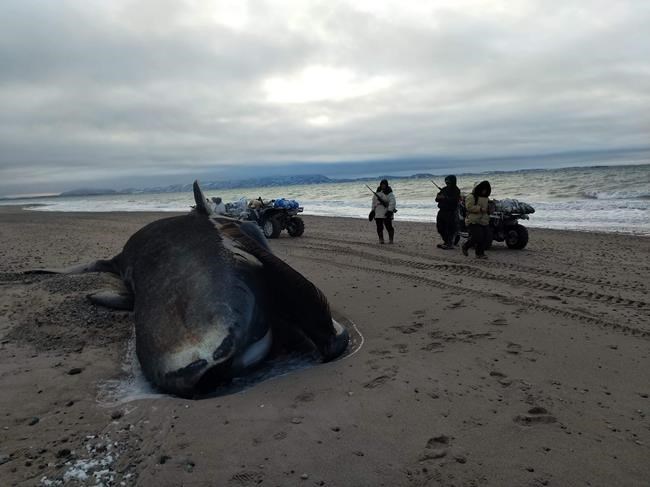Rene Kukkuvak was out polar-bear hunting with his family on Thanksgiving weekend when he came across something he had never seen before.
The hunters were 60 kilometres north of Kugaaruk in western Nunavut when they found four whale carcasses on the beach, waves swirling behind them.
"We stopped to take a look around for bears and I can see a seagull on top of a rock. As we got closer, I figured out it was a bowhead whale," Kukkuvak said.
After scanning the area in case the carcasses had attracted polar bears, the group took off only to find three more beached bowheads. Kukkuvak says the whales were "a few miles apart."
Kukkuvak snapped photos of the dead whales and posted them on Facebook.
Steve Ferguson, a research scientist with Fisheries and Oceans Canada, looked at Kukkuvak's photos and said the bowheads could have been attacked by killer whales.
He said the pictures show damage to the bowheads' tongues.
"That's a key piece of the whales that the killer whales like to eat."
The photos also show rake marks on the whales' sides, which Ferguson said could be from killer whale teeth.
It appears the whales were close together when they died, he said, but it is difficult to tell how all could have been killed at once. "It's just very unusual."
Ferguson said Nunavut hunters have told him over the years that groups of four to six killer whales have been known to take down a bowhead.
"Some hunters referred to them like wolves, in the sense that they would work together as a pack," he said.
Ferguson described how a killer whale might bite a bowhead's tail to keep it from swimming away or ram into its side to cause internal damage. It might also place itself over the bowhead's blowhole so it can't get air and suffocates.
Killer whales have been recorded in Baffin Bay and the Davis Strait for over a century, but spotting the mammals near Kugaaruk is "pretty unusual" and points to a loss of sea ice, Ferguson said. "They’re able to go further now."
Kugaaruk is nestled in western Nunavut between coastal mountains on the western side of the Simpson Peninsula.
Ferguson said less sea ice means killer whales can swim farther into the Kugaaruk area.
"It takes longer for the ice to form, so it’s really just a big playground they have now to find prey," he said.
"Having one of the lowest sea ice summers on record may have just given the killer whales a little more time to do this.”
But Ferguson added it's difficult to confirm whether killer whales were responsible for the bowhead deaths.
“If we had some good photographs, we probably could tell."
One alternative is that the whales were struck by a ship, but Ferguson pointed out there isn't much ship traffic around Kugaaruk.
"You would probably need a fairly large ship. Certainly the large iron ore carriers coming out of Baffinland at the Mary River mine would be able to kill a bowhead whale. But having said that, I can’t see how a whale struck up in Pond Inlet would somehow wash up around Kugaaruk."
Ferguson said Fisheries and Oceans is working with the community to collect samples from the whales that may help to determine how they died. Nunavut's pandemic travel restrictions only allow residents into the territory, meaning researchers can't fly up to do fieldwork.
"Hunters and guides and people up north have done some pretty tremendous work in our place. In a lot of ways, they've done it better than us."
---
This story was produced with the financial assistance of the Facebook and Canadian Press News Fellowship.
This report by The Canadian Press was first published Oct. 20, 2020.
Emma Tranter, The Canadian Press



